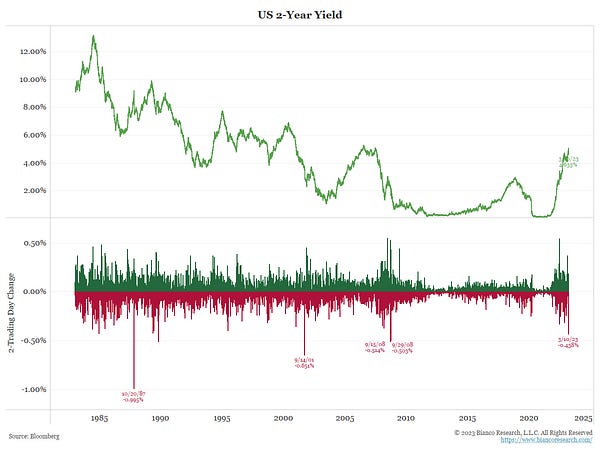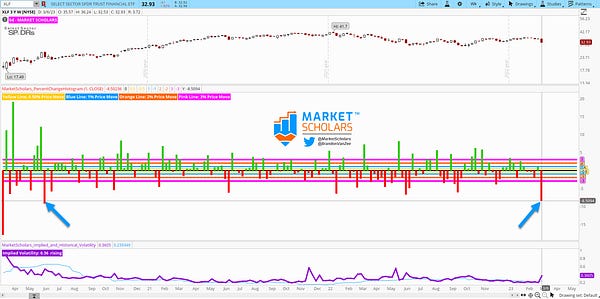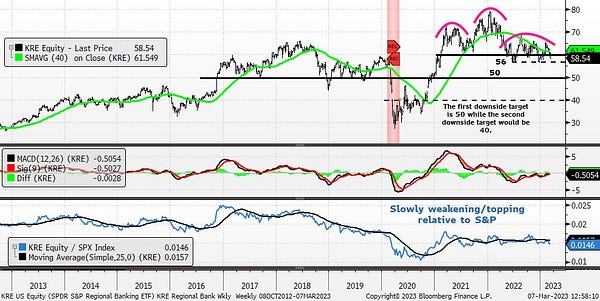Broad-Spectrum #17: Markets round-up
Silvergate, Silicon Valley, Signature. No more 50bps on the table?
Hello again,
Things got dynamic this week with multiple developments going viral in and outside of the U.S.
We have witnessed one of the top-20 largest banks in the U.S. go under in a matter of less than 48 hours.
The S&P 500 shredded -4.55% this week, lost its 200-DMA and anchored volume weighted average, slightly broke down from a major uptrend line, and credit spreads are widening. Basically the whole shebang.
And it is not only the SPX either.
Oh, and, guess who’s back?
And looks like, it will be an important thing again to look at in the coming sessions.
On top of what, we are not always going to talk about the market’s seasonality, right? Everything has their own seasonality, afterall. So does the VIX.
Anyway, let’s get back to the main point of our focus in this issue. The Silicon Valley Bank ($SIVB on NASDAQ), which is (or has been) quite famous with and known for their friendliness to venture capital firms, their niche focus of growth companies, early stage tech, web3, crypto companies just got decimated.
While we can talk about the reasons and discuss how their unique interest rate risk went overlooked and escaped the notice of analysts, we should also focus on what the aftermath might look like this week.
The Federal Reserve is expected to have an emergency meeting on Monday the 13th. They will discuss the possible roadmap going forward and ways to prevent any bank runs, a domino effect or contagion risk.
As of this moment, it seems that tons of new generation money is also gone with SVB.

It is certainly a mess out there.
But the stock already has been a mess for quite sometime. Just look at this 3-year weekly. It was going way ugly for SIVB 0.00%↑ until the The Federal Deposit Insurance Corporation closed it down.
Looks like Bitcoin in the early 2018.
Even though it is the second biggest bank failure in the financial history of the U.S., just a few weeks ago we saw another bank doing the same thing, it was the Silvergate. It did not matter as much and did not create the same big of an effect, because it simply was not the 16th biggest bank in the U.S.
Can this have a systemic effect though? Can this create a run on any similar bank this week?
The Treasury Department, Federal Reserve and Federal Deposit Insurance Corporation jointly said NO.
In the aftermath of the $SVIB blow-up though, we have seen a major pullback in the US 10yr yield.
In fact, the whole yield curve went down quite a ot actually, except for the front-end:
But it is actually not about that move itself. It is more about the velocity of that move. It happened FAST. It went down 44bps in the two days, and almost 66bps in 3 days.


Not so fast though, we have got the inflation numbers coming in on Tuesday. And it looks like the FEDs have this situation under control, sort of.
This did not impact the inversion in the 2Y-10Y much, though, because they both went down similarly. The level of inversion has been getting rather extreme. It was more than 1% before SVB happened. It now pulled back to 0.70%ish. I mean sure, it relatively went down A LOT.
In fact, how some put it on the street is that it is steepening extremely significantly. While this may be true, things still might not be over yet. We will see how the developments unfold this week.
This event probably wiped down the scenario of FED hiking 50bps on the next FOMC meeting on March 22nd as well, despite the fact, that just on Tuesday, Jerome Powell said in his testimony that we’ll see rates end up even higher than we anticipated in the first place. So there’s a silver-lining afterall, right?
Maybe not. On Sunday Evening, news broke out from the side of the FED and the US Treasury that the depositors will be protected. The regulators have stepped in. Maybe the FED will maintain on track for the “Higher for Longer” stance.
Let’s see if it can get back the $50B+ that was wiped out from the four big US banks in the last few days, and the major drop in KRE 0.00%↑ Regional Banks ETF.
Or the whole financial sector altogether.


Additionally, The Signature Bank will be shut down on Monday the 13rd by the regulator. Interesting things keep happening.
A final food for thought about the whole SIVB 0.00%↑ debacle:


About the pace of rate hikes, just a few weeks ago we had this picture:
Based on Fed Funds futures data, the market is currently expecting rates to move along the following schedule:
50bps hike to 5.25% on March 22nd
25bps hike to 5.50% on May 3rd
25bps hike to 5.75% on June 14th
Pause hikes on July 26th
Begin cutting rates on January 31st 2024
SOURCE: Blockware Intelligence Newsletter, Week 77
Now, people are chanting on twitter that rate cuts are scheduled to take place next week. Well, maybe not that early. But you get the idea.
It seems GS 0.00%↑ already started the trend.

And the futures shot up after the authorities’ announcement.
They are not letting the Silicon Valley Bank go down in flames.
I guess the 16th largest bank in the U.S. is also too big to (let) fail.
We’re back to the QE, folks, for a short amount of time.
We will watch closely how the dot plot will change on the FOMC meeting on 22nd on March. For reference, here’s the latest one:
Well, just two real quick conclusions out of that:
The world on the street is, when it comes to bank runs, or the race for information and analysis, it is similar to market crashes. Meaning, that:
People shoot(sell) first and ask questions later.
People are probably already worried about their other bank/bank-related stocks in their portfolios and holdings, trying to figure out whether or not if it jumps to others, whether or not this there’s going to be a contagion or a spillover effect.
And a lot of people are worried about European Banks more than the US Banks, in fact, most people would have expected something like this to happen in the Europe first, maybe in Italy, more specifically
We can’t know for sure if something like this happens in Europe, but if something like this does happen in Europe, it will be way messier, as we think that the regulatory authorities will probably not be able to broker a emergency-contingency plan in a span of 24-48 hours when the markets are closed, and come up with announcements that will buffer the possible tail-end effects of such an event in the markets.
When we look at globally, it looks like we already need to ponder if this will continue.
What’s more bad news, is European Banks are quite overweight in the European Funds’ portfolios.
Futures are up before the market open this week. The fast-moving picture depicts that the FEDs saved the day until something else happens.


Let’s see how this picture will changed. But this week definitely promises to be a news-dependent, volatile and dynamic.
This will be a fun one. A dynamic and volatile week ahead.
Broad Spectrum Finance will also be back soon.
Stay tuned.
Sources
Twitter, Quantifiable Edges, Bar Chart, Jim Carroll, Mike Zaccardi, The Kobeissi Letter, StockCharts, Bloomberg, Katie Greifeld, USTreasuryYieldCurve.com, Jim Bianco, GRIT Capital, AllStar Charts, Brandon Van Zee, Peter Mallouk, Unusual Whales, EPFR, Barclay’s Research, The Market Ear Newsletter, da Chart Life, The Daily Shot Newsletter, The Chart Report


















